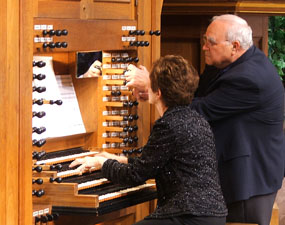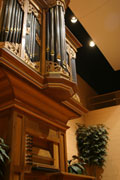
Southern's Organs

Anton Heiller Memorial Organ
Southern’s beautiful Anton Heiller Memorial Organ contains 4,861 pipes in 108 ranks for its 70 stops. The organ was designed to help meet three spiritual needs: worship, beauty, and positive emotional expression. It is constructed of more than seven types of wood, including white oak, western red cedar, Brazilian rosewood, sugar pine, maple, and beech. The pipes, moldings, and key nosings are gilded with 23-carat goldleaf; the manual sharps, stop knobs, and keytable moldings are made of African ebony. Each element is fashioned to create the best acoustic properties.
The Anton Heiller Memorial Organ is located in the Collegedale Church of Seventh-day Adventists.
History
The organ bears the name of Anton Heiller in memory of the original adviser for the Southern College organ project. Heiller (1923-1979) was one of Europe’s most famous organists and versatile musicians. He wrote his first composition at age 12 and went on to become an accomplished pianist, harpsichordist, composer, and improvisor. During the Southern College organ project, Heiller shared many of his personal insights, including recommendations on where to place the stops.
The organ was constructed over a four-year period beginning in June 1981. The builder, John Brombaugh, assembled it in his shop in Eugene, Oregon, and then had it delivered to Southern in October 1984.
During the dedication on April 26, 1986, the organ was played by guest musicians from around the world, including Klaas Bolt, Peter Planyvsky, William Porter, Michael Radulescu, Leonard Raver, and Harald Vogel. Now it graces the church and lends beauty to the worship services, study, concerts, and recitals.
Southern’s beautiful Anton Heiller Memorial Organ contains 4,861 pipes in 108 ranks for its 70 stops. The organ was designed to help meet three spiritual needs: worship, beauty, and positive emotional expression. It is constructed of more than seven types of wood, including white oak, western red cedar, Brazilian rosewood, sugar pine, maple, and beech. The pipes, moldings, and key nosings are gilded with 23-carat goldleaf; the manual sharps, stop knobs, and keytable moldings are made of African ebony. Each element is fashioned to create the best acoustic properties.
The Anton Heiller Memorial Organ is located in the Collegedale Church of Seventh-day Adventists.
History
The organ bears the name of Anton Heiller in memory of the original adviser for the Southern College organ project. Heiller (1923-1979) was one of Europe’s most famous organists and versatile musicians. He wrote his first composition at age 12 and went on to become an accomplished pianist, harpsichordist, composer, and improvisor. During the Southern College organ project, Heiller shared many of his personal insights, including recommendations on where to place the stops.
The organ was constructed over a four-year period beginning in June 1981. The builder, John Brombaugh, assembled it in his shop in Eugene, Oregon, and then had it delivered to Southern in October 1984.
During the dedication on April 26, 1986, the organ was played by guest musicians from around the world, including Klaas Bolt, Peter Planyvsky, William Porter, Michael Radulescu, Leonard Raver, and Harald Vogel. Now it graces the church and lends beauty to the worship services, study, concerts, and recitals.

The Opus 27
Southern’s second organ, the Opus 27, contains two manuals and 13 stops. It is one of only six mean-tone tempered organs built in the 20th century. Mean-tone tuning was used in the 16th and 17th centuries by composers of early Baroque and Renaissance music. Unlike equal temperament, which provides an equal distance between tones and easy transposition from one key to another, mean-tone tuning is based on the mathematical proportion of the major third. Thus, this organ gives students a unique insight into the way early compositions were conceived. Chromatic passages, for instance, take on a striking character that is lost on modern instruments.
The Opus 27 is housed in Ackerman Auditorium, a two-story, 258-seat recital hall.
Southern’s second organ, the Opus 27, contains two manuals and 13 stops. It is one of only six mean-tone tempered organs built in the 20th century. Mean-tone tuning was used in the 16th and 17th centuries by composers of early Baroque and Renaissance music. Unlike equal temperament, which provides an equal distance between tones and easy transposition from one key to another, mean-tone tuning is based on the mathematical proportion of the major third. Thus, this organ gives students a unique insight into the way early compositions were conceived. Chromatic passages, for instance, take on a striking character that is lost on modern instruments.
The Opus 27 is housed in Ackerman Auditorium, a two-story, 258-seat recital hall.